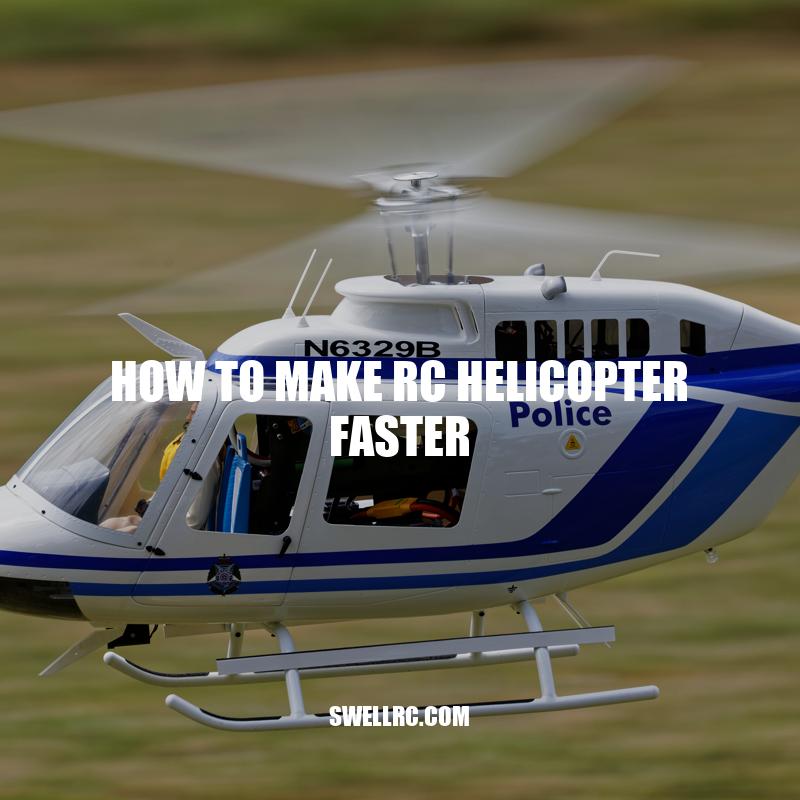5 Tips to Boost Your RC Helicopter’s Speed
RC helicopters are a fascinating machine to play with for enthusiasts and hobbyists, and understanding the mechanics is crucial to making the most out of this hobby. One of the key aspects of owning an RC helicopter is that you can upgrade, tinker and experiment with your helicopter to make it run smoother, achieve more speed and reach greater heights. If you are looking for ways to make your RC helicopter faster, there are some essential steps to understand and follow. It’s essential to know that the best ways to increase your helicopter’s speed involve a combination of adjustments in both hardware and software. In this article, we will be discussing these steps in detail to help you achieve a faster RC helicopter. With the tips below, you will be able to adjust various components of your RC helicopter such as the motor, blades, weight and voltage, to increase its speed, performance and efficiency.
Upgrade the Motor
One of the main factors that influence the speed of your RC helicopter is the motor, and upgrading to a brushless motor is an effective way to increase its speed. Here are some tips for upgrading your motor:
- Choose a motor with a higher kv rating to achieve faster rotation speed.
- Use a motor with more power output, measured in watts.
- Ensure the motor has good quality bearings for more efficiency and reduced heat generation.
- Some popular brushless motors brands that are well-suited for RC helicopters include Align, T-Motor and Scorpion.
You can easily find brushless motors online, and it can be helpful to read reviews and compare specifications to find the best option for your particular RC helicopter model. Do your research and make sure the motor is compatible with your helicopter before purchasing.
What is the RPM of RC helicopter motor?
The RPM (revolutions per minute) of an RC helicopter motor can vary depending on the model and specifications of the motor.
However, on average, the RPM of an RC helicopter motor is around 30,000 RPM.
If you’re interested in purchasing an RC helicopter motor, there are many websites and products available for you to choose from, such as:
- HobbyKing.com
- TowerHobbies.com
- Amazon.com
Adjust the Pitch of Blades
The pitch of rotor blades is also crucial for the speed of your RC helicopter. Adjusting the pitch of blades allows you to alter the angle of attack, which affects the lift generated by the blades. Here are some tips for adjusting the blade pitch:
- Use a pitch gauge to ensure the blades are at the correct angle.
- Increasing the pitch of blades will deliver more lift and, in turn, a faster speed.
- A negative pitch will reduce the lift and enable you to slow down or land the helicopter.
In addition, wider rotor blades with increased surface area can deliver more lift than narrow blades. However, it’s important to ensure the weight of the blades doesn’t exceed the maximum load capacity of the helicopter.
Here is a table that shows the recommended blade pitch angle for different types of RC helicopters:
| Helicopter Type | Recommended Pitch Angle |
|---|---|
| Beginner | 0°-2° |
| Intermediate | 3°-5° |
| Expert | 6°-9° |
Note that these are general recommendations, and you should always refer to the user manual or seek expert advice before adjusting the pitch angle of blades.
What is the pitch angle of RC helicopter blade?
The pitch angle of an RC helicopter blade refers to the angle at which the blades are set relative to the plane of rotation. This angle determines the amount of lift generated by the blades and affects the helicopter’s stability, speed and maneuverability.
Some websites that offer information on RC helicopter blades and their pitch angles are:
- www.rcgroups.com
- www.helifreak.com
- www.rc-heli.com
Products that offer adjustable pitch angles for RC helicopter blades include:
- Blade MSR RTF Helicopter
- Blade CX3 MD520N BNF Helicopter
- Blade Nano CP X RTF Helicopter
Reduce Weight
The weight of your RC helicopter can impact its speed and overall performance. Reducing the weight can result in a faster and more responsive helicopter. Here are some tips for reducing the weight of your RC helicopter:
- Remove unnecessary parts such as landing gear or any additional electronic devices that are not required.
- Use a lighter battery with a higher power-to-weight ratio.
- Use a lightweight canopy instead of a heavier one.
- Avoid adding extra weight to the helicopter by not exceeding the maximum load capacity.
It’s important to note that the weight reduction should be done in a balanced way so that the center of gravity remains stable. Too much tinkering with the weight distribution could result in a loss of control.
Additionally, you can find a variety of lightweight parts and accessories available for RC helicopters, such as carbon fiber blades, skids, and tail booms. However, it’s crucial to ensure that any upgrades or replacements are compatible with your particular RC helicopter model.
Some affordable lightweight upgrades and replacement parts can be found on Amazon, Banggood, and other hobby websites.
What is the power to weight ratio of RC helicopter?
The power to weight ratio of an RC helicopter is a measure of its power output in relation to its weight. It is calculated by dividing the power output (in horsepower) by the weight of the helicopter (in pounds).
- A typical power to weight ratio for an RC helicopter is around 0.5 to 1 horsepower per pound.
- Helicopters with a higher power to weight ratio will be able to fly more efficiently and perform more advanced maneuvers.
- Factors that can affect the power to weight ratio include the size and type of helicopter, the motor and battery used, and any modifications made to the helicopter.
If you’re looking to purchase an RC helicopter with a good power to weight ratio, consider checking out websites such as Horizon Hobby or Tower Hobbies.
Improve Aerodynamics
Improving the aerodynamics of your RC helicopter can lead to increased speed and better overall performance. Here are some tips for improving the aerodynamics of your RC helicopter:
- Use streamlined rotor blades for better lift and reduced drag.
- Consider upgrading to a more efficient and aerodynamic canopy.
- Ensure the helicopter is well-maintained and free of damage or wear.
- Use a balancing tool to ensure all parts of the helicopter are aligned properly.
Improving the aerodynamics of your helicopter can also lead to increased stability and control, allowing for more precise maneuvering.
There are a variety of tools and accessories available for improving the aerodynamics of your RC helicopter, such as aerodynamic blades, canopies, and stabilizers. Upgrades and replacement parts can be found on Amazon, Banggood, and other hobby websites.
However, it’s crucial to ensure that any upgrades or replacements are compatible with your particular RC helicopter model, and that they are installed correctly to avoid adversely affecting the helicopter’s performance.
How do you reduce drag on a helicopter?
Reducing drag on a helicopter can drastically improve its efficiency and performance. Here are some ways to achieve this:
- Streamline the body and rotor blades design
- Reduce weight by using lighter materials
- Multi-axis servo controls to minimize excessive maneuvers that can cause turbulence and increase drag
- Use high-performance rotor blades that are designed to reduce vortex drag
- Clean and maintain the helicopter regularly to ensure optimal performance
For more information on helicopter performance and maintenance, visit websites such as Aviation Voice and Helicopter Maintenance Magazine.
Increase Voltage
Increasing the voltage of your RC helicopter’s battery can lead to increased speed and overall performance. However, it’s important to use caution when increasing the voltage in order to avoid damaging your helicopter’s electronics. Here are some tips for safely increasing the voltage and speed of your RC helicopter:
- Consider upgrading to a higher-voltage battery for increased power output.
- Ensure that your helicopter’s electronics are capable of handling the increased voltage.
- Monitor the temperature of the motor and electronics to prevent overheating.
- Use a voltage regulator to keep the voltage at a safe level for your helicopter’s electronics.
- Check with the manufacturer or a qualified RC technician to ensure that your helicopter is suited for increased voltage operation.
There are a variety of high-voltage batteries and voltage regulators available for purchase online through sites such as Amazon, Banggood, and HobbyKing. It’s important to ensure that any upgrades or replacements are compatible with your particular RC helicopter model, and that they are installed correctly to avoid adverse effects on the helicopter’s performance.
While increasing voltage can be an effective way of increasing speed and performance, it should be approached with caution and proper research. It’s important to prioritize safety and proper maintenance when working with RC helicopters to ensure that your hobby remains fun and enjoyable.
What Voltage should a RC Helicopter be?
- The voltage of a RC helicopter battery mainly depends on the size and power of the helicopter.
- Typically, RC helicopter batteries range from 3.7 volts to 22.2 volts.
- For beginners, it is recommended to start with a battery voltage of 3.7 to 7.4 volts.
- For advanced users, a voltage of 11.1 to 22.2 volts is recommended for more powerful and larger models.
For more information about RC helicopter batteries and their specifications, check out websites such as Horizon Hobby or Amazon.
Conclusion
In conclusion, making an RC helicopter faster is an exciting and rewarding experience for any hobbyist. By upgrading the motor, adjusting the blade pitch, reducing weight, improving aerodynamics, and increasing voltage, you can significantly increase your helicopter’s speed and performance.
It’s important to prioritize safety when working with RC helicopters and to take proper precautions when performing upgrades or modifications. Always ensure that any upgrades or replacements are compatible with your particular RC helicopter model and that they are installed correctly to avoid adverse effects on the helicopter’s performance.
There are numerous resources available online to help you get started with making your RC helicopter faster, including online forums, instructional videos, and hobby shops. Before beginning any modifications or upgrades, take some time to research and understand the basics of RC helicopter maintenance and modification.
By following these tips and best practices, you can achieve the desired increase in speed and performance for your RC helicopter, and enjoy even more thrilling and exciting flights.



